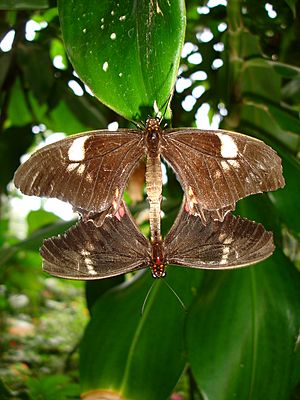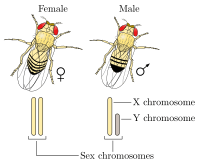Sex facts for kids

Sex is a way that living things make new life. It's how plants, animals, fungi, and even tiny single-celled organisms create offspring. Usually, it involves two different individuals from the same species combining their genes to make a new, unique organism.
Contents
How Living Things Reproduce
Organisms can reproduce in different ways:
Asexual Reproduction
This method means an organism can make copies of itself without needing another partner. For example, a tiny amoeba can simply split into two new amoebas. Some jellyfish and many insects can also produce offspring from eggs without needing fertilization. This is like making a clone of the parent.
Sexual Reproduction
Most plants and animals reproduce sexually. This means two parents are involved. Each parent makes special cells for reproduction. A new organism starts when these two types of cells join together to form a fertilized egg, called a zygote.
- Organisms that make sperm are called male.
- Organisms that make ova (eggs) are called female.
- Some organisms, like most snails, are called hermaphrodites. This means they can make both sperm and egg cells.
Some animals and plants can even switch between sexual and asexual reproduction depending on what's best for them.
Why Sexual Reproduction is Important
Asexual reproduction might seem easier because you only need one parent. However, both ways of reproducing have good points and not-so-good points:
- When an offspring is made asexually, it gets all its genes from just one parent. This means it's almost identical to that parent.
- When an offspring is made sexually, it gets genes from both parents. This makes the offspring genetically a little different from either parent. This difference is super important for how species change and adapt over time.
Humans and Sex
In humans, a person's sex is usually either male or female. For example, John is male, and Jane is female. This difference is sometimes called gender.
A person's sex is decided by special chromosomes they get from their parents. A woman's egg cell always has an X chromosome. A man's sperm can have either an X or a Y chromosome.
- If an egg and a sperm with an X chromosome combine, the baby will have two X chromosomes (XX) and will develop into a girl.
- If an egg and a sperm with a Y chromosome combine, the baby will have an X and a Y chromosome (XY) and will develop into a boy.
Sometimes, very rarely, the process of making these sex cells can have small differences. This might lead to a person having a different combination of chromosomes, like XXX or XXY. These differences can sometimes lead to unique physical or mental traits.
Before babies are born, they develop either male or female body parts.
Evolution of Sexual Reproduction
Sexual reproduction first appeared about a billion years ago. It developed in tiny, single-celled organisms called eukaryotes. Scientists still talk about why it started and why it's still around today.
One main reason is that sexual reproduction creates lots of variety in offspring. If some traits help an organism survive better, they can spread more easily through the population. Traits that are not helpful tend to disappear quickly.
Sexual reproduction is found only in eukaryotes. These cells have a nucleus and mitochondria. Besides animals, plants, and fungi, other eukaryotes like the malaria parasite also reproduce sexually. Some bacteria can share genetic material through a process called conjugation, which mixes traits, but it's not the same as sexual reproduction.
In sexual reproduction, the special cells used are called gametes. These are either eggs or sperms. For fertilization to happen, two different gametes must join. When a sperm enters an egg, the egg quickly changes to stop any other sperm from getting in.
How Sex is Determined
In biology, sex determination is about how an organism develops into male or female, not just how they look. In humans, males and females often look different. But in many other species, they look very similar, except for their reproductive organs.
Sex can be determined in different ways:
- Hermaphrodites produce both male and female gametes. This system is found in some animals, like snails, and in most flowering plants.
- In most cases, there are separate sexes. This means an organism produces either male gametes (sperm) or female gametes (eggs), but not both at the same time. The biological reason an organism becomes one sex or the other is called sex determination.
When sex is determined, there are two main ways it can happen:
- The sex is decided by the genes the organism gets from its parents.
- The sex is decided by the environment around the organism.
Genetic Sex Determination
Usually, an organism's sex is determined by its genes. With genetic sex determination, the genes that control sexual development are often on special chromosomes called sex chromosomes. Because sex is controlled by these chromosomes, there are usually about the same number of male and female offspring. For example, in humans, sperm carry either an X or a Y chromosome, and they are made in roughly equal amounts.

Environmental Sex Determination
For some species, sex is not determined by inheritance (genes), but by things in the environment while they are developing or later in life. Many reptiles have temperature-dependent sex determination. This means the temperature of the eggs during development decides if the baby will be male or female. For example, in some turtles, lower temperatures produce males, while higher temperatures produce females. This difference in temperature can be as small as 1 or 2 degrees Celsius.
Some fish can even change their sex during their life. This is called sequential hermaphroditism. In clownfish, the smaller fish are male, and the biggest, most dominant fish in a group becomes female. In many wrasse fish, it's the opposite: most fish are born female and become male when they reach a certain size. These fish can produce both types of gametes over their lifetime, but they are only one sex at any given time.
In some ferns, the default sex is hermaphrodite. However, if ferns grow in soil where hermaphrodites have grown before, hormones left in the soil can make the new ferns develop as male.
Related pages
See also
 In Spanish: Sexo para niños
In Spanish: Sexo para niños



